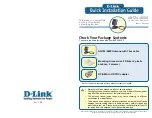
Installation and User Manual
EtherHaul
1200™
Page 62
EH-INST-02, Issue 4.0
6
EtherHaul Networking Configuration
This chapter presents the EtherHaul bridge management model and describes the initial
procedures for configuring the EtherHaul network, including:
Provider Bridge
EtherHaul Bridging Model
Configuring VLANs
Configuring Bridge Ports
Configuring Provider Bridge and Advanced VLAN Settings
6.1
Provider Bridge
The IEEE 802.1ad Provider Bridge, commonly known as QinQ or Provider Bridge, extends
the IEEE 802.1Q standard by providing for a second stack of VLANs in a bridged network.
The general purpose of Provider Bridge is to enable frames from multiple customers to
be forwarded (or tunneled) through another topology (provider network) using service
VLANs or S-VLANs. The provider bridge, which may consist of multiple devices in the
service provider domain, looks like a simple bridge port to the customer’s traffic and
maintains the customer’s VLANs.
Customer VLANs (referred to as C-VLANs by the IEEE 802.1ad specification) are not used
to make any forwarding decisions inside the provider network where customer frames
get assigned to service VLANs (S-VLANs). Inside the provider cloud, frames are
forwarded based on the S-VLAN tag only, while the C-VLAN tag remains shielded during
data transmission. The S-VLAN tag is removed when the frame exits the provider
network, restoring the original customer frame.
The EtherHaul 1200 incorporates a fully functional integrated Provider Bridge (IEEE
802.1ad).
















































